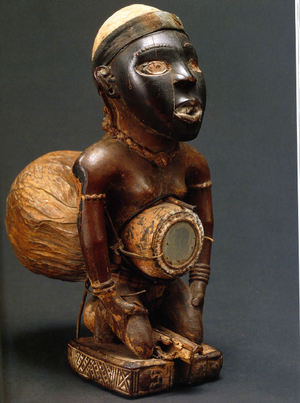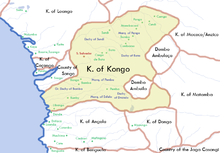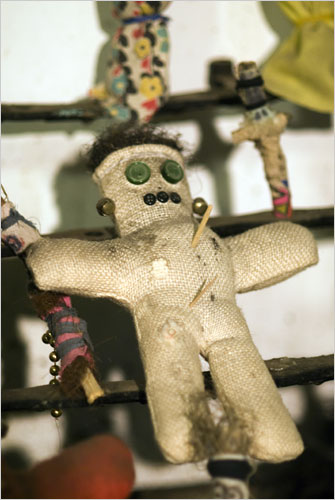The Nkisi:

Minkisi (the plural of nkisi, which literally means "things which do things") are 19th century wooden figurines, in the shape of humans, created more than a century ago in Kongo (present-day DRC and Angola.) Conceptually, Minkisi are containers that capture the spirit of the dead and make it available for use by the living, through a complex relationship of people-thing-spirit. They have been distributed across the world by God, and attributed special powers. For the BaKongo people, malevolent spirits are everywhere, and no illness or death is accidental. Therefore, chiefs and minkisi must be used to counteract and appease these powers. The living can use the Minkisi to inflict harm upon a person, ranging from a headache to falling off a cliff. However, the living cannot simply control the spirit of the Nkisi- there are two steps to the process. Firstly, a person seeking help-- to catch a thief or have a healthy pregnancy-- must visit the local chief, nganga and ask him for help. For pay, he will contact the Nkisi and ask it to find the culprit or solve the problem. The crucial role of the chief, nganga is filling a medicine pouch and attaching it to the nkisi, or even incorporating in the nkisi's body. The pouch can then be filled with various substances, depending on the nkisi's purpose. This medicine gives the Nkisi power and officially identifies it as a spirit. The Minkisi have they have their own will and are considered very similar to people. The Minkisi imposes rules, and if you violate them, it can punish you.There are many different categories, both physical and metaphorical, in the Minkisi. The most important minkisi are vital agents of justice for whole communities in terms of wealth, justice and healing. During the Belgian colonization of the Kongo, Minkisi were severely repressed, firstly because they were considered pagan and secondly because they were considered dangerously powerful witchcraft. They were burnt or confiscated, and members of the military deemed them members of an opposing political force.
Kingdom of Kongo:

The Voodoo doll:

Although its origins are not completely clear, the Voodoo doll originated in the Fon people of present-day Benin. The Voodoo religion was created in slave quarters in Haiti and Louisiana, when the faiths of various peoples began to intermingle. I will be focusing on the use of voodoo dolls in Louisiana, which grew enormously during the life of Marie Lavaux, the 'queen of Voodoo'.The word Voodoo itself means spirits and Voodoo is a religious or magico-religious practice which aims at connecting spirits and mortals. This interaction is only possible through a magical process using a gris-gris. A gris-gris' definition is nuanced-- it can either be the magical act or the object used for magic, or even both. Voodoo steers away from its more religious base into the superstition it is commonly associated with when a gris-gris is treated as containing the magic in itself. Spirits are no longer the strongest force; the magic can come from the gris-gris itself. The voodoo doll is a gris-gris, but can be used as a religious object or a superstitious one depending on how the user treats it. The voodoo doll is usually a small, soft doll representing a person, though the extent of physical detail may vary. This doll, lying alone on a table, is no different from any other type of doll. However, the sharp pins which accompany the doll make it a voodoo doll. The person handling the doll has complete control over the doll, and can push the pins into the entirety of its soft body, attaching strands of hair or the name of the subject to the doll. The concept rests on this body being the material incarnation of a person, although religious usage of the voodoo doll uses outside spirits.
Both the voodoo and the nkisi doll are inanimate objects to whom great powers are attributed, but in different ways. When these objects are given agency, the supposed segregation between thing and human is further blurred. Externally, the two figurines may seem similar in their function, but their purpose, materiality and use in social context differentiates them greatly. The Nkisi is very much used to maintain and regulate social order, whereas the voodoo doll is extensively used for personal needs. This is crucial to understanding the nuances of the doll.
Definitions:
- Minkisi: A thing that does things.
- Nkisi: a spirit personality controlling a particular activity or function. Also, a material composite through which such a spirit can be approached.
- Nkondi: a loosely defined class of nkisi whose functions included “hunting” witches and other unknown wrongdoers. Many are wooden figures stuck full of nails and other hardware. From konda, to hunt at night.
- Nganga: expert owner-operator of an nkisi.
- - -
- Voodoo: A religion that is derived from African polytheism and ancestor worship (Merriam- Webster)
- Gris-gris: An amulet, charm, or spell of African origin (Webster dictionary)
- Loa: Spirits in Voodoo religion.
- Legba: He is the most important spirit, who gives or denies permission to speak to the other spirits. He is the first and last invoked in Voodoo ceremonies.
Back to The Voodoo doll
